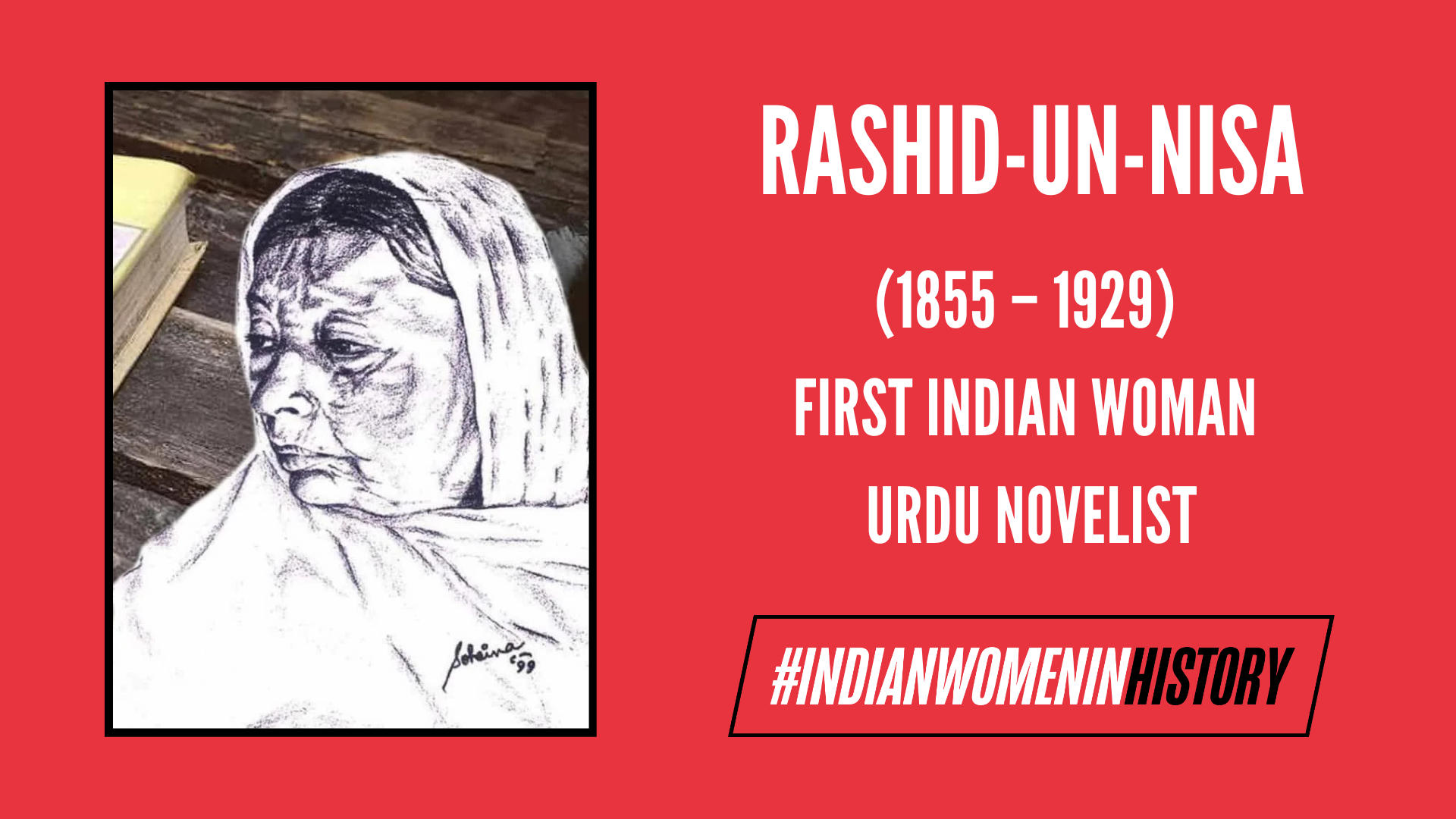When the novel ‘Islah-Un-Nisa‘ first made its presence in the Urdu literary world of unpartitioned India, the book mentioned the author as ‘Mother of Barrister Sulaiman, Daughter of Syed Wahiduddin Khan Bahadur, and Sister of Imdad Imam’. At that time, it was considered morally outrageous for a woman to wield power and reflect social reality with unflinching courage and honesty. In those times, Rashid-un-Nisa, now renowned as India’s first female Urdu novelist, channeled her inner rebellion not to be bogged down by the patriarchs but to ink her name in history as a pioneer of women’s education and social reforms. Her work continues to inspire and inform generations of women, while marking a silent impression on India’s literary legacy.
Between Margins And Spaces: Early Life And Background
Rashid-un-Nisa was a woman who chose to live non-defiantly, going by her name. Translating to ‘rightly guided among women‘, derived from the word Rashid, meaning rightly guided, and un-Nisa, meaning of women, she became a symbol of resistance in her time, with her rebellion scribbled onto the pages of history in ink and the spaces between words.
Also known as Rashidatun Nisa and Raseedan Bibi, she was born to Shamsul Ulama Syed Waheeduddin Khan Bahadur in Patna, Bihar, in 1855. Her notable achievements include opening a school for girls in Bihar, considered to be the first institution in the city dedicated to the cause of women’s upliftment, apart from authoring an Urdu novel, thereby breaking into a male-dominated field.

Despite coming from an educated background, Rashid-un-Nisa didn’t receive any formal education and was mainly tutored at home. However, the rich intellectual setup with her father being an Islamic scholar served as an impetus, sparking her intellectual curiosity and a testament to the great heights she was meant to achieve. Her subsequent matrimonial alliance with the lawyer Maulvi Mohammad Yahya introduced her to the progressive sphere of literature, sharpening her keen interest in the landscape of words with the power to shape transformation.
The Forces Shaping Rashid-un-Nisa
From the beginning, the content of most Urdu novels revolved around women’s emancipation and the social taboos faced by them. Maulvi Nazeer Ahmed’s ‘Mirat Ul-Uroos’, published in 1869, and ‘Binat Un-Nash’ were the footsteps, bearing stories around women’s education and their social status.
It wasn’t before the convention of Madarsatul Uloom in 1857 in Aligarh that opening up the avenues of modern education for Muslim women became a rallying call in India, in correspondence to the Egyptian counterparts. Combined with British efforts to incentivise the process through cash rewards by recognising books that would promote the idea of women’s education, gradual social acceptance began to happen.
It was the collective result of these concentrated efforts that inspired Rashid-un-Nisa to hold a pen and defy social norms, using it as a tool for rebellion in the Muslim society of the times, plagued by the urgent need for reform and bound in backwardness. The Muslim modernists of North India, struggling to assimilate themselves within the newly emerging colonial cartography that was coming to define India as an idea, were faced with “double consciousness” running parallel to the growth and expansion of rich Urdu literature.
‘Islah Un-Nisa’: A road to reform Beyond Confines
‘Islah Un-Nisa’, directly translating to ‘rectify or reform women’, became the symbol of vocal social resistance that attempted to break the mould, while raising women’s consciousness about the numerous ways through which they could ameliorate their social status. Advising women on the pressing need for education against ignominy as well as broad-mindedness through stories about literate women to give a strong foundation to her ideas, Rashid-un-Nisa’s novel met severe constraints at the time of publication.

It kept languishing untouched amidst discarded papers until her son, Mohammad Sulaiman, returned to India after completing his formal education. In her novel, she writes, “One advantage of Mohammad Sulaiman getting a higher foreign education is that the book which was lying among waste papers for 13 years will now be published. May Allah grant him success in his life.”
Through her novel, she navigates the complex world of Islamic superstition, unreasonable societal constraints, and regressive social customs that sought to turn women into passive agents with no voice of their own. Her encounter with the themes in Mirat-Ul-Uroos encouraged her to inspire those reading her legacy to turn the tables and press for reform around them, instead of living their lives in a bubble that sought to invisibilise them and their immense potential.
Written in a simple and easily understandable tone to be widely understood by women, the book holds a distinguished position in Urdu literature, resulting in a remarkable rise in the stature of Rashid-un-Nisa, despite not being widely recognised by critics.
Divided into eight sections Harf-e-Aghaaz (the preface), Daura-e-Awwal (first phase), Islah-Un-Nisa (part one), Islah-Un-Nisa (part two), Shairin Biyan (sweet narration), Urdu ki Pehli Khwateen ki Novel Nigaar (the first female novelists of Urdu), Mashoor Khawateen ke Taaruf aur Tehqiqi Kitab (biographical and research work on famous women), and Zarreen Dasta (golden hand)—the book is situated within the context where women had no autonomy whatsoever, and these sections, when pieced together, formed a skeleton seeking to blend spiritual teachings with practical advice.
Her work follows several short stories following the main story of Bismillah with delightful descriptions surrounding childbirth and marriage, thereby documenting several cultural strands with remarkable grace, interspersed with local regional songs. Blending the belief that intellectual, spiritual, and moral growth were significant for women, her characters embody the values of enlightenment and self-improvement, thereby sending the message that women must shun all regressive norms to achieve intellectual excellence.
Its literary significance cannot be overstated. Written in a simple and easily understandable tone to be widely understood by women, the book holds a distinguished position in Urdu literature, resulting in a remarkable rise in the stature of Rashid-un-Nisa, despite not being widely recognised by critics. Through her vivid portrayal of social customs, her work was a mirror to her thoughts, marking a significant milestone in Urdu literature.
The Woman Who Inked Resistance
Rashid-un-Nisa today stands as a mere name in history known to few, particularly those exclusive to historical and cultural anthropological research. However, much of that can be owed to the patriarchal criss-cross of barriers overlapping to deliberately omit her contributions to Islamic women’s reform. Her book, ‘Islah Un-Nisa’, republished three times, can today be located in Patna’s Khuda Bakhsh library, reprinted in 2007 with critical notes by other scholars, including Zahidada Hena, Sohail Azimabadi, and Adeeb Sohail.
However, through her work, ‘Islah Un-Nisa’ expanded the scope for reform from its moral sphere to press for the need to open the avenues of Western education for women, along with some degree of recognition beyond their domestic obligations.
With significant push and support, she opened the first school for women in Patna, with its building being provided for by the Maharani of Bettiah, making it renowned as the ‘Bettiah House’. Lady Frase, the wife of the then Lt. Governor of Bihar, visited the school in 1906 and was said to have been deeply impressed by it.
Through her contributions, Rasheed-un-Nisa strived to reform the women of her time who were tied to extreme superstition and gullibility. She believed access to education, in particular an assimilation of the English language by women, could lead to the acquisition of social respect for them.
A cursory glance at the work of the times reveals that only two novels ‘Mirat-Ul-Muroos’ (Maulvi Nazeer Ahmed) and ‘Surat Khayal’ (Shad Azeem Abadi), held social and moral significance. However, through her work, ‘Islah Un-Nisa’ expanded the scope for reform from its moral sphere to press for the need to open the avenues of Western education for women, along with some degree of recognition beyond their domestic obligations.
Legacy And Urdu Renaissance
Zahida Hena has drawn her comparisons with Rashsundari Devi, one of the first Bengali women to have written an autobiography of her own. Zahida goes on to argue that even Raja Ram Mohan Roy had a far less glowing personal life despite being called ‘the father of the Indian Renaissance.’
She draws similar parallels with Rokeya Sakhawat Husain, a prominent Bengali social reformer and writer who diagnosed the difficulties that women faced in a patriarchal society.
Rashid-un-Nisa passed away in 1929, but her enduring legacy continues to inspire generations of women. Her life is a testament to the struggles faced by women in those times, where men attempted to bury their contributions beneath the sand by inserting the names of male associates in the family as the author, thereby restricting women to being “daughters, wives, or mothers of someone” with no identity whatsoever.
Today, it is not difficult to imagine a woman holding a pen to power, challenging social norms. However, in the times of Rasheed-un-Nisa, a pen and paper were almost always linked to male power, with women facing ridicule, backlash, and abuse. Despite that, she stood, and today, she stands as the first female novelist at the turn of the 19th century to write in Urdu and shun the society, asking for change, thereby redesigning the overarching structure of Urdu literature and Islamic norms.
About the author(s)
Nausheen is currently an undergraduate student pursuing journalism at Lady Shri Ram College for Women, Delhi University. With a keen interest in feminism, geopolitics, and social issues, her passions lie in research, writing, and public speaking. In her free time, she enjoys listening to music, sipping coffee, and playing chess.





